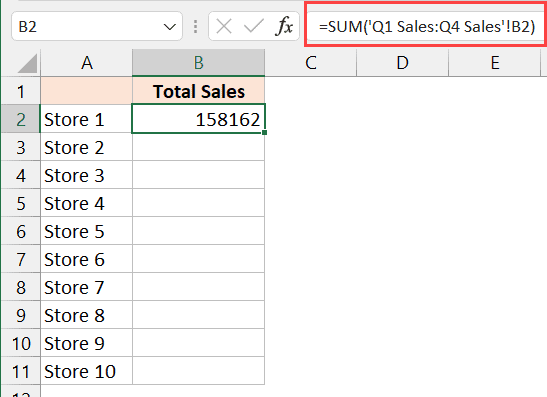5 Ways to Sum Numbers Across Excel Sheets

Excel is an invaluable tool for number crunching and data management, and one of the most common tasks is summing numbers across multiple sheets. Whether you are an accountant, a financial analyst, or just someone trying to organize their personal finances, mastering the art of summing numbers across Excel sheets can greatly enhance your productivity. Here are 5 effective methods to help you sum numbers from various sheets in Excel seamlessly:
Method 1: Using 3-D References

3-D references allow you to reference the same cell or range of cells across multiple sheets at once. Here’s how to use this method:
- Select the cell where you want the total sum to appear.
- Start typing your formula, e.g.,
=SUM(. - In the formula, use the sheet name range, like
Sheet1:Sheet5, followed by an exclamation mark!, and then the cell or range of cells you want to sum, for example,Sheet1:Sheet5!A1. - Complete the formula with
)and press Enter.
Example:
=SUM(Sheet1:Sheet5!A1)
🚀 Note: Ensure all sheets you're summing from exist in the workbook, or else the formula will return an error.
Method 2: Using the SUMIF or SUMIFS Function

This method is useful if you need to sum numbers based on specific conditions:
- Enter the SUMIF formula in the desired cell:
=SUMIF(range, criteria, [sum_range])or=SUMIFS(sum_range, range1, criteria1, [range2], [criteria2], ...). - Specify the range across sheets by listing each sheet and the respective cell/range, like
Sheet1!A1:A10.
Example:
=SUMIF(Sheet1:Sheet5!A1:A10, ">50")
Method 3: Consolidating Data with 3-D References

Instead of manually typing each sheet, you can use Excel’s consolidation feature:
- Go to the Data tab and select Consolidate.
- In the Function dropdown, choose Sum.
- Add references from each sheet by selecting them one by one using the Reference input field, and click Add after each selection.
- Ensure Create links to source data is unchecked unless you want to create a linked summary.
📌 Note: Consolidation works well with structured data but can be overwhelming with disorganized spreadsheets.
Method 4: Using INDIRECT and SUM Functions

The INDIRECT function lets you construct cell references by text:
- Type
=SUM(INDIRECT("Sheet" & ROWS(A$1:A1) & "!A1"))in your desired cell. - Copy this formula down to sum across multiple sheets.
Example:
=SUM(INDIRECT("Sheet1!A1") + INDIRECT("Sheet2!A1") + INDIRECT("Sheet3!A1"))
Method 5: Combining INDEX and MATCH Functions

This method is more advanced and involves dynamic referencing:
- Create a list or table of sheet names you want to sum from.
- In the cell where you want the total, use the following formula:
=SUMPRODUCT(INDEX(INDIRECT(“‘” & SheetNames & “’!A1:A10”), MATCH(SheetNames, SheetNames, 0)))
Where SheetNames is your list or table of sheet names.
In summary, Excel provides several methods for summing numbers across sheets, each with its own set of uses:
- 3-D References: Ideal for summing the same cells across multiple sheets quickly.
- SUMIF or SUMIFS: Useful when conditional summing is required.
- Consolidation: Perfect for structured data and easy summing.
- INDIRECT with SUM: Allows for dynamic referencing based on text inputs.
- INDEX and MATCH: For a more complex, yet flexible, approach to summing data.
Each method has its strengths and can significantly simplify your work in Excel, making data analysis more efficient. Whether you're dealing with financial data, project management, or personal budgeting, these techniques can save time and reduce errors in calculations.
As you begin to incorporate these methods into your workflow, remember that Excel’s flexibility allows for customization, so experiment to find what works best for your specific needs.
Can I use these methods if my sheets have different names?

+
Yes, you can. For methods like 3-D references and INDIRECT, you can list sheet names manually or use a dynamic list for referencing.
What if the data I need to sum is not in the same cell across sheets?

+
Methods like SUMIF/SUMIFS or using INDIRECT with a helper column where you list the cell references from each sheet will help you sum data in different cells.
How can I handle errors when a sheet doesn’t exist?

+
You can use the IFERROR function to return a custom message or value if a sheet name used in your formula is invalid or the sheet doesn’t exist.
Are there any limitations to these Excel summing techniques?

+
One major limitation is with 3-D references; if any cell in the reference range is blank or contains text, it can cause errors in summation. Also, dynamic methods like using INDIRECT might slow down Excel with very large datasets.